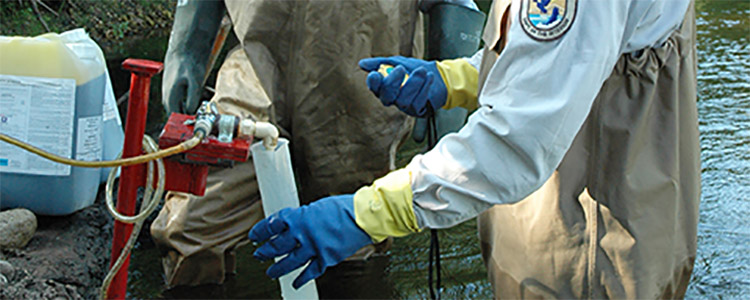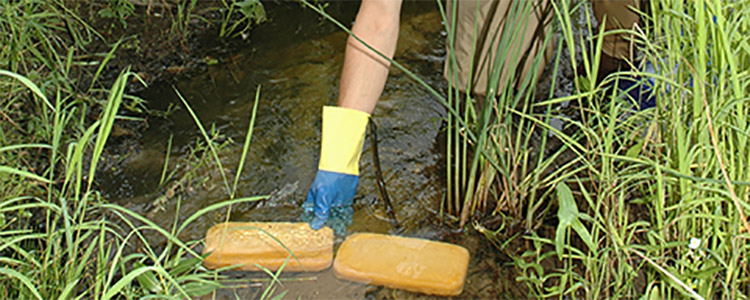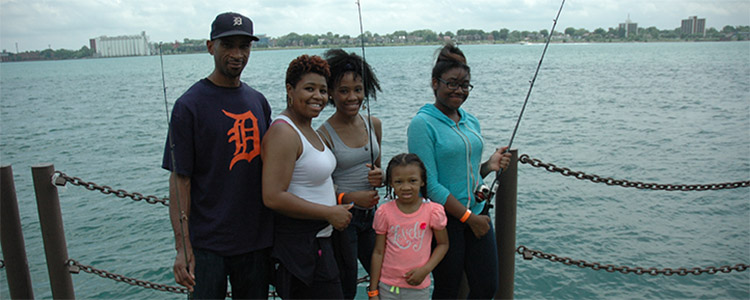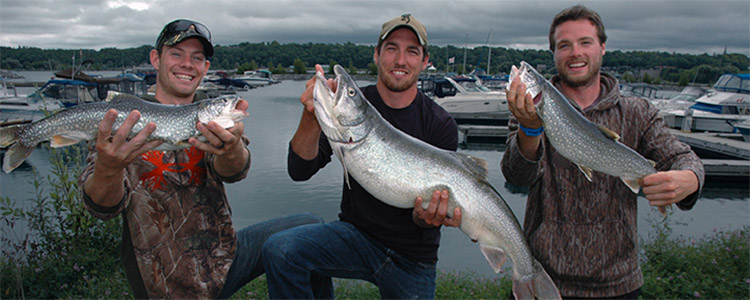Finding the Sea Lamprey’s Kryptonite
This article is based on a recent paper, Use of physiological knowledge to control the invasive sea lamprey (Petromyzon marinus) in the Great Lakes, published in Conservation Physiology: A Changing World – problems and solutions, available at: https://academic.oup.com/conphys/pages/changing_world_problems_solutions.
Authored by the Commission’s Deputy Sea Lamprey Program Director, Dr. Michael Siefkes, the open access article is available at: https://academic.oup.com/conphys/article/5/1/cox031/3858388?searchresult=1
Imagine a prehistoric snake-like, jawless fish that thrives by feeding on the blood and body fluids of unsuspecting aquatic victims. This creature uses its mouth as a deadly weapon, by latching onto its prey with formidably powerful suction, rasping into its flesh with hundreds of splinter-sharp teeth, and penetrating its innards with its drill-like tongue . A creature so resilient, it has survived at least four major extinction events and easily embarked upon a journey from its native home in the salty depths of the Atlantic Ocean to the fresh, relatively confining waters of the Great Lakes. Feeding on a seemingly endless buffet of fishes—any fish it wants, really, for it has no enemies here—it transforms from mere parasite to vicious predator. Only one in seven victims survives the attack. As public panic mounts, the population of this savage creature explodes, increasing exponentially. The economy of an entire region and the livelihoods of hundreds of thousands of people are on the brink of collapse. Can anything stop the sea lamprey?!?
This is not an excerpt from a sci-fi novel or the latest Marvel comic. This is a true story that is all too familiar to commercial and recreational anglers, tourism operators, and those who recreate in the Great Lakes. The sea lamprey invasion, which began in Lake Ontario in the early 19th century, resulted in the loss of thriving commercial and sport fisheries. But as we all know, every super-villain has its weaknesses. Since the early 1950s, researchers have studied the sea lamprey’s physiology—how an organism functions and behaves, including physiological processes required for normal function—to find its weaknesses. As it turns out, several aspects of the sea lampreys physiology are its kryptonite; that is, its greatest weakness is itself.
"Success of any pest control program lies in gaining an intimate understanding of the biology and ecology of the target organism."
~Dr. Mike Siefkes, Journal of Conservation Physiology
Although sea lampreys are anadromous, meaning they migrate from salt water to fresh water to spawn, their invasion into the Great Lakes in the early 1920s showed their physiological capability to adapt completely to a fresh water system. Sea lampreys begin life as filter-feeding larvae that reside innocuously burrowed in stream sediments for three to possibly ten or more years. They then undergo a significant metamorphosis in which they develop their lethal mouth, as well as eyes, and migrate out into the open lake to feed on fish. During their parasitic stage, which lasts 12-18 months, each sea lamprey can slaughter up to 40 pounds of fish. Following this massacre, lampreys move back into suitable spawning streams, reproduce, and die.
The Sea Lamprey Control Program, implemented by the Great Lakes Fishery Commission, capitalizes on the unique physiology of sea lampreys to develop methods to control this deadly predator. Researchers identified the first physiological vulnerability that can be exploited for control during the lampreys’ larval stage. Sea lamprey control agents apply lampricides, selective pesticides, to larvae-producing streams, which exterminates approximately 93% of the population. The primary lampricide used, TFM, disrupts energy metabolism in larvae sea lampreys. Compared to other fishes, sea lampreys have low levels of the enzymes necessary to eliminate TFM from their bodies, which eventually leads to their death. The other lampricide applied by the Sea Lamprey Control Program, niclosamide, is often used as an additive to TFM during larger treatments to reduce cost but maintain the effectiveness and selectivity of treatments. Like TFM, niclosamide is known to affect the metabolic processes of sea lampreys, but the specific lethal mechanism is an ongoing research topic.
The larvae that survive lampricide treatments metamorphose and move toward the lake, ready to attack and annihilate their prey. There is no method of control in existence to stop parasitic sea lamprey once they have reached the lakes.
After sea lampreys have completed their methodical terrorization of the fish community for a year to year-and-a-half, they begin the last stage of their life cycle, where they migrate back toward a suitable stream to spawn. During the adult life stage, the Commission is able to exploit several physiological vulnerabilities for control: the sea lampreys’ poor swimming ability, their inability to jump very high (<18 inches), and their persistent drive to reach and move up streams to spawn. Each female can produce up to 100,000 eggs, so limiting their ability to spawn and the amount of habitat they can infest is critical to successful control. The Commission relies on a network of sea lamprey barriers to reduce the amount of spawning habitat available to sea lampreys, which also reduces the need to treat those areas with lampricides. The design of these barriers is continually improving as more and more research on sea lamprey behavior and swimming performance is conducted.
Using these methods of control, the Sea Lamprey Control Program has become the most successful aquatic vertebrate invasive species control program in the world. Today sea lamprey populations have been reduced by 90% in most areas of the Great Lakes, allowing fish stocks—and the fishery and economy—to make an extraordinary comeback—a remarkable success!
Your ancestors called it magic, but you call it science. I come from a land where they are one and the same."
~Thor
The story, however, does not end there. Ongoing research is examining other physiological processes that could prove useful in developing future control methods. Sea lampreys communicate through olfaction—the sense of smell—via pheromones and other cues. By manipulating the olfactory communication system of the sea lamprey, scientists have shown they can promote certain behaviors, such as stream selection, upstream migration, swimming toward a trap, or avoiding a certain area in a stream. Field studies are currently underway to determine how these compounds may be best used to support the control program.
Researchers have also sequenced both the mitochondrial and nuclear genome of the sea lamprey and are working to identify specific genes associated with key physiological processes. This line of research could open up an entire realm of control techniques that are currently out of reach.
As an invasive species in the Great Lakes, sea lampreys have proven to be a worthy opponent. They are resilient creatures and demand a vigorous, unrelenting, and cutting-edge counter-attack to keep their population in check. In its battle with the sea lamprey, the Commission’s duty is to find those weaknesses and use them to save the Great Lakes fishery. The Commission will not relent in this mission!
Read more Pulse on Science: Project Spotlights
- New Study Concludes Invasive Sea Lampreys Can Be Controlled by the Release of Sterilized Males
- Happy 75th anniversary to Hammond Bay Biological Station!
- Great Lakes Habitat Restoration: Partnering to Promote Fish Production
- Sea Lamprey Control Spreads the Distance
- Making the Best of a Bad Situation: Great Lakes Sea Lampreys Reveal the Origins of Vertebrate Traits
- Studying the Fish of Buffalo Reef, Traverse Bay, Lake Superior
- Doing Science is Essential...Communicating Science is Just as Critical (and maybe more FUN!)
- Faithful Fish: Walleye Show High Spawning Site Fidelity in the Great Lakes
- Finding the Sea Lamprey's Kryptonite
- Good Things Come in...Polymer Packages?
- Rambunctious Reproduction Overheard Among Great Lakes' Lake Trout
- Clearer Water Means Less Fish: Understanding How Lower Trophic Level Changes Impact Lake Huron's Fisheries







